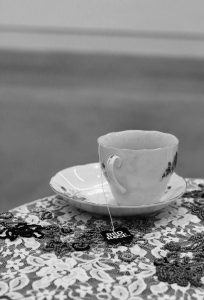Everyday policies and institutions associated with white society render a scrutinized measurement of what constitutes ‘indian-ness’ for Indigenous people. These colonial constituents of Indigeneity are systemically pervasive, contributing to an overwhelming amount of shame and disconnection that perforates our Indigenous cultures and evoke an equally pervasive lateral violence. This shame, paired with our contemporary political climate also creates an interference to establishing any foundation for Indigenous and settler people to engage with one another in a healing and politically generative way. Creatively negotiating her shared ancestry of settler and the settled, these opposing cultural tensions are something that Métis visual artist, Maria-Margaretta from Treaty 6 territory in Saskatchewan, understands at her core.
When I met Maria three years ago, she was carrying around questions like how to rationalize seeing part of herself as the oppressor to another part and how to identify as Native socially, while her skin is assumed white, therefore bringing her into white privilege. Instead of needing to answer these questions, Maria made work that presented these questions just as they were, which is what continues to make her work so heartbreaking in the best possible way: it’s honest.
Native identity and experience is not solely an Indigenous story, but one shared by its settlers, where we all inhabit a colonized topography and political system. For Margaretta, she understands that cultural hybridity is not something to reconcile and instead, embodies the simultaneity of her identity in a way that allows her to deconstruct and inherently decolonize the part of her which oppresses another: the colonial mindset. Intrinsic to her work, Margaretta highlights how Native re-presentation of identity can build and change eurocentric systems of knowledge production and in so doing, re-define both an Indigenous and colonial gaze within this context. Actively engaging with the term métissage, Margaretta takes up the notion of cultural hybridity as a contemporary synthesis, where the expectations of the colonizer/white-settler and Indigenous relationship and the erasures of Native representation begins to unravel.
 Margaretta describes her work as “making mistakes of resurgence.” “I’m working conceptually with cultural resurgence and Métis identity, showing what my experience with this is and a lot of that lives in the mistakes.” In her piece, I Learn my Culture From the Internet, she takes up western tropes associated with Métis identity and re-presents them by performing them in a familiar, but unexpected and carefully curated context. For this performance, Maria sat at a table in the gallery, following YouTube tutorial videos about beading. She had a little metal contraption that I remember looking at with Native envy (I want to be authentic and make bead stuff, too), that assisted in making tightly formed, freestanding beaded lines. Despite the tutorial video or the assistant metal contraption, her beads weren’t perfect, but the length of the beaded rope continued to grow with visible mistakes showing themselves against the white gallery surfaces.
Margaretta describes her work as “making mistakes of resurgence.” “I’m working conceptually with cultural resurgence and Métis identity, showing what my experience with this is and a lot of that lives in the mistakes.” In her piece, I Learn my Culture From the Internet, she takes up western tropes associated with Métis identity and re-presents them by performing them in a familiar, but unexpected and carefully curated context. For this performance, Maria sat at a table in the gallery, following YouTube tutorial videos about beading. She had a little metal contraption that I remember looking at with Native envy (I want to be authentic and make bead stuff, too), that assisted in making tightly formed, freestanding beaded lines. Despite the tutorial video or the assistant metal contraption, her beads weren’t perfect, but the length of the beaded rope continued to grow with visible mistakes showing themselves against the white gallery surfaces.
“Beading is fucking hard and you make a lot of mistakes. I think there is a point where you can snip the thread and let the beads fall and start again or you can take that as a part of your learning lesson. For me, these little mistakes are what makes the piece, it’s me investing in a cultural practice of resurgence. It’s this wild possibility of two things coming together, how different all these patterns are and these little mistakes or twists or tying of knots end up being a grandeur project. These little imperfections are what I love about my work. These imperfections are growth.”
I asked Maria how these mistakes influence the way she negotiates making work that subverts colonial rhetorics of indigeneity at the risk of perpetuating them. “I think it’s a big risk. I think my work is going to be met with criticism or at least, resistance. I don’t want my work to seem like a rejection or acceptance of either side of my identity.” In her work, Elbows off the Table, Margaretta uses readymade british colonial signifiers (doilies, tea cups and saucers) and Indigenous signifers (beading) and subtly subverts their inherent meaning by re-presenting them through a blended engagement with one another. This is a moment where I worry choices like this could be polarizing, with a potential to perpetuate oppressive colonial narratives, but while each readymade signifier can be understood singularly, when presented as a métissage, meaning is not readily located and an enriched understanding begins to unfold as the colonial gaze is forced to shift.

There is an immediate unease that Margaretta creates with her beads, as their presence illuminates the Métis reality hidden in the materiality of the british doily and tea cup. The doily is sewn material made up two sections: one of solid white flower designs, the rest being open space with thin lines of material connecting each flower. As the beads indiscriminately travel each section, the division of solid white against sinews of open space reveals the materiality as a hidden narrative of cultural hybridity and at once, turns the british doily in on itself as a means to its own colonial end.
Offering to somehow remove colonial strategies of erasure and racist structures of domination by ‘othering’ her white privilege, Margaretta uses an Indigenous strategy developed by Gerald Vizenor, where the “post-Indian” uses humour and wit as tactics to gain cultural and political autonomy. Something called survivance. “I’ve always felt that I’ve had an underlining satirical element in my work, but I want to bring the satire and humour that we have as Indigenous people, that we need to have in order to survive, and utilize it more within my work.”
I see this humour unfold where the beads meet the cup and saucer, as the red rose tea bag limply, but fully extends out of the cup, red trying to escape. The saucer is unable to sit flush against the table, because of the presence of beads and the british items are unable to perform their function without Native disruption (finally, a shift in a narrative that has been the opposite since european contact). As the tea cup is destabilized by the beads, so is the associated coloniality of Métis identity. And it’s fucking funny.
We survive.
Challenging the colonial rhetoric that has been incised into our Indigenous consciousness, the provocative, yet subtle subversions inherent within Margaretta’s work outline the everyday struggle of confronting misrepresentation and the internal process of self-representation associated with Métis identity. By isolating each expectation of coloniality and western tropes of indigeneity, it allows us to have control over them, which we can then manipulate and ultimately regain an autonomous identity. In doing so, Margaretta’s art offers a space to re-think colonial constructions of representation and creates an opportunity to reduce and reconcile the tensions between these two opposing cultural identities.

Looking ahead, Margaretta will be spending a year working in Vancouver with her mentor, Catherine Blackburn, a prolific artist based in Saskatchewan of Dene and european ancestry and member of English River First Nation, where they’ll be decolonizing the politics of visuality versus visibility and challenging the expectations of private and public spheres as it relates to cultural practice and expression. When I asked how her heart doesn’t break everytime she encounters the colonial rhetorics of indigeneity, she said that “Art is a place to dedicate elements of tradition in a way that generates reclamation of identity. I believe that sustaining a connection to ancestral ways of making is directly connected to creative expression through revitalization and Indigenous sovereignty.”
Before running off to Rebecca Belmore’s artist talk, I asked who her audience is: “How my work is understood is really up to the viewer. I think my work is supposed to be confrontational. If you look at it and say ‘haha, I get that’ or look at it and say “oh shit,” either way …” she trailed off asking herself what she wanted to say about how her work is received, resigning with, “I don’t know, do racists go to art galleries?” I think it’s a great question and is exactly what Margaretta’s work asks of us all. As she reveals the hidden métissage of identity, she asks us what hidden blending of subtle racisms quietly exist in a colonized mindset.
As Margaretta continues to share her Métis identity with us through her art and daily life, perhaps we can learn to embrace that our stories are shared, hybrid and nuanced. Perhaps if we can learn this, both white-settler and Indigenous identities would have an expressive opportunity they otherwise haven’t. Through examples of re-presentation, like the ones Maria-Margaretta offers, we can begin transforming colonial constructions of representation and lift ourselves us up from a place of systemic racism and lateral violence to a place of cultural strength and understanding, of possibility.


